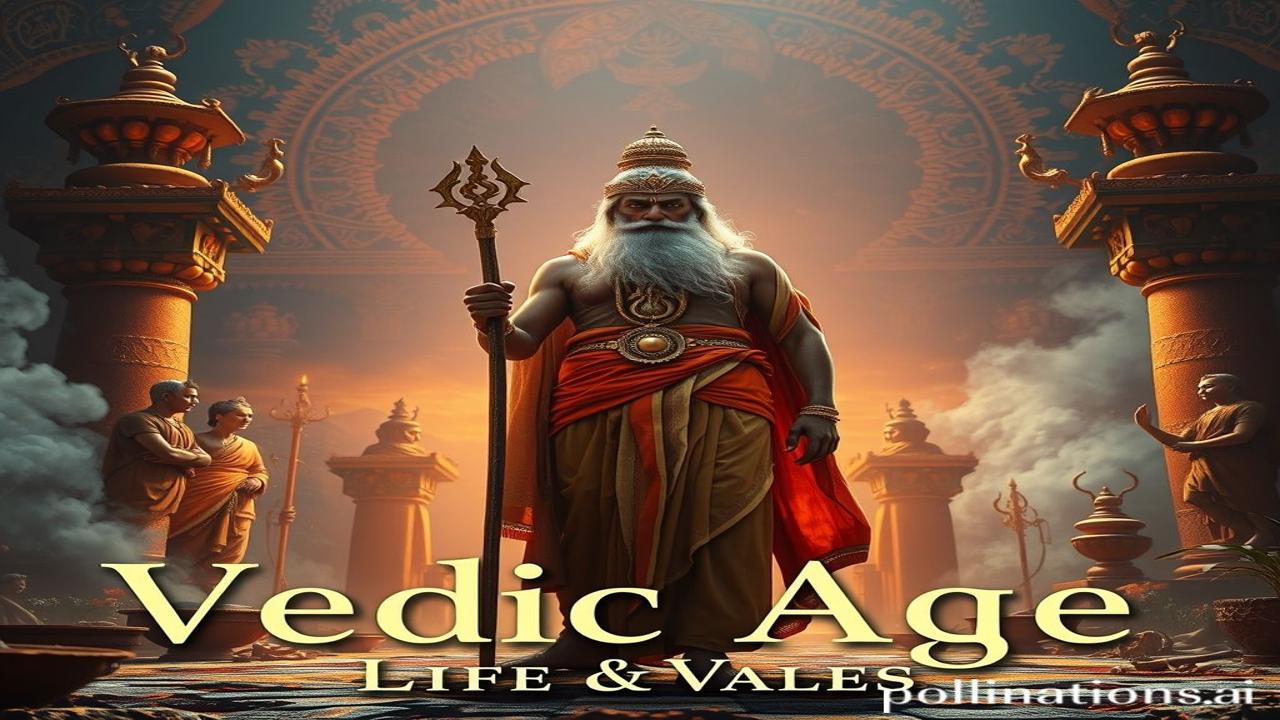Vedic Age: A Journey Through Time and Values
Kabhi socha hai, jab suraj pehli baar Bharat ki dharti par chamka hoga, tab kya hua hoga? Imagine, the air thick with the smell of sandalwood and freshly churned ghee, the chants of ancient mantras echoing in the forests. That’s the Vedic Age, folks – a time of sages, hymns, and the very foundation of what we call Bharatiyata today. Lets delve into this fascinating chapter of our history!
The Dawn of Civilization: Understanding the Vedic Age
The Vedic Age, spanning roughly from 1500 BCE to 500 BCE, is a period of immense importance in Indian history. This is when the Vedas – the oldest scriptures of Hinduism – were composed. It’s like discovering the original source code of our culture! Think of it as the blueprint upon which much of Indian philosophy, religion, and social structure was built.
The Aryans, believed to have migrated from Central Asia, are often associated with the Vedic Age. They brought with them their language, Sanskrit, and their rich oral traditions. The Vedas (Rigveda, Samaveda, Yajurveda, and Atharvaveda) are not just religious texts; they are a window into the lives, beliefs, and values of the people of that era. From the mighty Indus Valley Civilization, slowly but steadily moving towards the Ganges plains – the Vedic people gave a new definition to the nation.
Life in the Vedic Age: A Glimpse into Daily Life
Imagine this: It’s early morning, and the sounds of cowbells fill the air. Maa Yashoda is preparing for the yajna, meticulously arranging the ingredients. Her husband, a farmer, is already out in the fields, tending to his crops of barley and wheat. Their children are learning the sacred chants from their guru in the gurukul.
Life revolved around the grama (village), with agriculture and animal husbandry being the primary occupations. The society was structured into four varnas – Brahmins (priests), Kshatriyas (warriors), Vaishyas (merchants), and Shudras (laborers). While the varna system later solidified into a rigid caste system, in the early Vedic Age, it was more fluid and based on occupation.
The Vedic people were deeply spiritual. They worshipped natural forces like fire (Agni), water (Varuna), and wind (Vayu). The yajna was a central ritual, a way to connect with the divine and seek blessings.
Think of राजा दशरथ, planning a grand Ashwamedha Yagya! His queen कौशल्या is deeply involved, ensuring everything is perfect for the deities. The air is filled with the aromatic smoke of burning herbs and the rhythmic chanting of mantras – a powerful sensory experience!
Vedic Values: Shaping the Indian Identity
The Vedic Age wasn’t just about rituals and social structures; it was about values. Values like Satya (truth), Dharma (righteousness), Ahimsa (non-violence), and Karma (action and consequence) were deeply ingrained in their way of life. These principles continue to guide and influence Indian society even today.
The concept of Vasudhaiva Kutumbakam – the world is one family – also has its roots in the Vedic Age. This idea of universal brotherhood and interconnectedness is more relevant than ever in our globalized world.
The Echoes of the Vedas Today: A Living Legacy
How often do we hear the chanting of mantras in temples or at auspicious ceremonies? These are the same mantras that resonated through the forests and villages of the Vedic Age. The rituals, festivals, and even the way we approach life, are deeply influenced by the Vedic traditions.
Yoga, a practice that has taken the world by storm, is a direct descendant of the Vedic philosophy. Its emphasis on physical, mental, and spiritual well-being reflects the holistic approach to life that was central to the Vedic Age.
Even the concept of Atithi Devo Bhava – treating guests as gods – is a reflection of the Vedic values of hospitality and respect. So many aspects of our culture and identity are built on the foundation laid down during the Vedic Age.
Myth-Buster: Vedic Age and the Caste System
Log samajhte hain ki the caste system was always a rigid and oppressive structure. Lekin asli sach yeh hai ki in the early Vedic Age, the varna system was more flexible and based on occupation. It wasn’t until later that it became hereditary and deeply entrenched in society. Understanding this nuance is crucial to truly understanding the history of India.
Sensory Journey: Experiencing the Vedic World
Imagine walking through a Vedic village. The air is filled with the scent of freshly baked bread and the sounds of children playing. The temple walls are adorned with intricate carvings depicting scenes from the Vedas. You can feel the warmth of the sun on your skin and the soft earth beneath your feet. The evening air is cool with the sounds of rhythmic drumming and chanting as the villagers celebrate a good harvest.
A Timeless Message: Final Thoughts
The Vedic Age, with its hymns, rituals, and values, laid the foundation for the rich and diverse culture of India. It’s a reminder that our past is not just a collection of dates and events; it’s a living legacy that continues to shape our present and future.
As the Upanishads beautifully state, “असतो मा सद्गमय । तमसो मा ज्योतिर्गमय । मृत्योर्मा अमृतं गमय ॥” – From untruth lead us to truth, from darkness lead us to light, from death lead us to immortality. The Vedic Age, in its essence, is a journey towards enlightenment and a deeper understanding of ourselves and the universe. So, let’s keep exploring, questioning, and learning from the wisdom of our ancestors. Let the flame of Bharatiyata burn bright!
